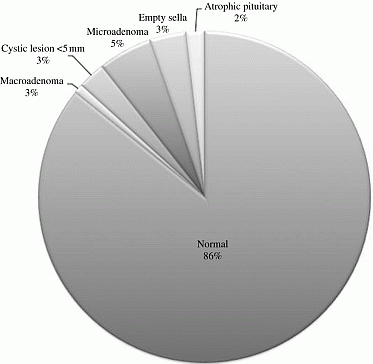SFEBES2012 Poster Presentations Clinical practice/governance and case reports (90 abstracts)
Low prevalence of pituitary pathology in men presenting with isolated hypogonadotrophic hypogonadism
Fraser Gibb , Mark Strachan , Nicola Zammitt & Brian Walker
Edinburgh Centre for Endocrinology, Edinburgh, United Kingdom.
Background: Male hypogonadotrophic hypogonadism is an increasingly common cause of referral to endocrine clinics. Subnormal testosterone levels are frequently observed in obesity, type 2 diabetes mellitus and in the elderly. Endocrine Society guidelines suggest stratification of investigations based on the degree of androgen deficiency, with full pituitary function testing and MRI recommended only in those with serum testosterone levels less than 5.2 nmol/L. However the evidence upon which these recommendations are based is limited. Aim To discern the rate of pituitary pathology, on imaging, in men presenting with hypogonadotrophic hypogonadism.
Methods: Retrospective review of all men (mean age 53±1 y) referred to the Edinburgh Centre for Endocrinology with hypogonadotrophic hypogonadism, between 2006–2010, where pituitary imaging was requested (n = 113). Anterior pituitary function was assessed in the majority of patients (LH, FSH, Testosterone, SHBG, Prolactin, ACTH-stimulated cortisol, TSH and free T4).
Results: The yield of pituitary pathology detected by imaging and full pituitary function testing was small in men presenting with secondary hypogonadism (figure). Only one macroadenoma (13 mm - intrasellar) was detected, occurring in a 54 year old man with otherwise normal pituitary function and a testosterone of 7.8 nmol/L. Within this cohort, anterior pituitary function testing did not reveal a single additional hormone deficiency (table).
Discussion: The level of pituitary pathology detected in this series was arguably no greater than that expected in the general population. Pooling of experience between centres may permit further refinement of the recommended thresholds for pituitary imaging. Development of simple tests to distinguish between functional and structural pituitary disease would be of value in limiting recourse to expensive imaging investigations.
Summary of pituitary function


Declaration of interest: There is no conflict of interest that could be perceived as prejudicing the impartiality of the research reported.
Funding: No specific grant from any funding agency in the public, commercial or not-for-profit sector.





